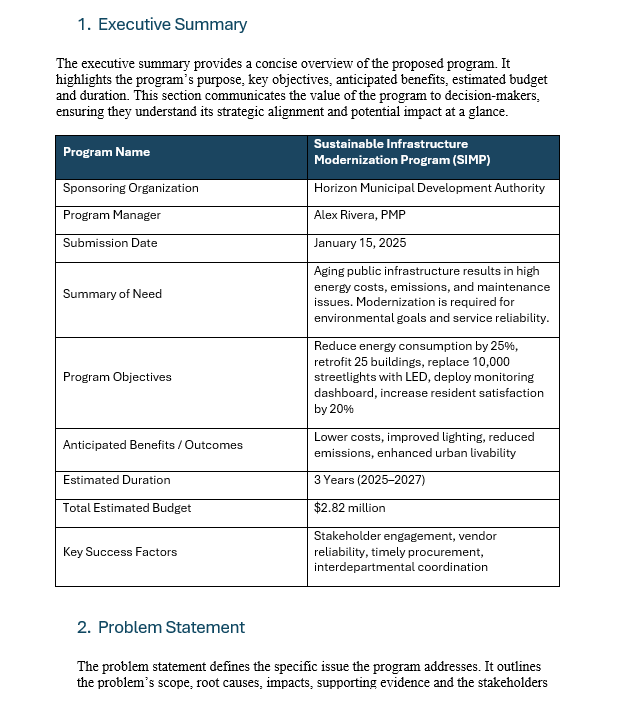A program proposal template is a structured document that outlines the goals, scope and execution plan for a new program or initiative. It serves as a guide for organizing ideas, identifying resources and gaining stakeholder approval. Using a template helps ensure every important detail is captured, from objectives and deliverables to timelines and budgets.
Program proposals are essential for turning strategic ideas into actionable plans. Teams can use a program proposal template to present information in a clear and consistent way, making it easier for decision-makers to evaluate and approve the proposal. The template also provides a repeatable framework for future programs, saving time and maintaining consistency across projects.
Project management software supports this process by turning the approved program proposal into a working plan. Once objectives and milestones are defined, software tools can schedule tasks, allocate resources and track progress in real time. This ensures that the program stays aligned with organizational goals from proposal to delivery.
ProjectManager is the best choice for taking your program proposal and transforming it into a fully managed plan. With dynamic roadmaps, Gantt charts, dashboards and collaboration tools, our software helps you visualize every phase of execution, link dependencies, filter for the critical path and set a baseline to track progress in real time. You can balance workloads and adapt quickly to change and use AI-powered reporting to ensure the program achieves its intended results on schedule and within budget. Get started with ProjectManager today for free.
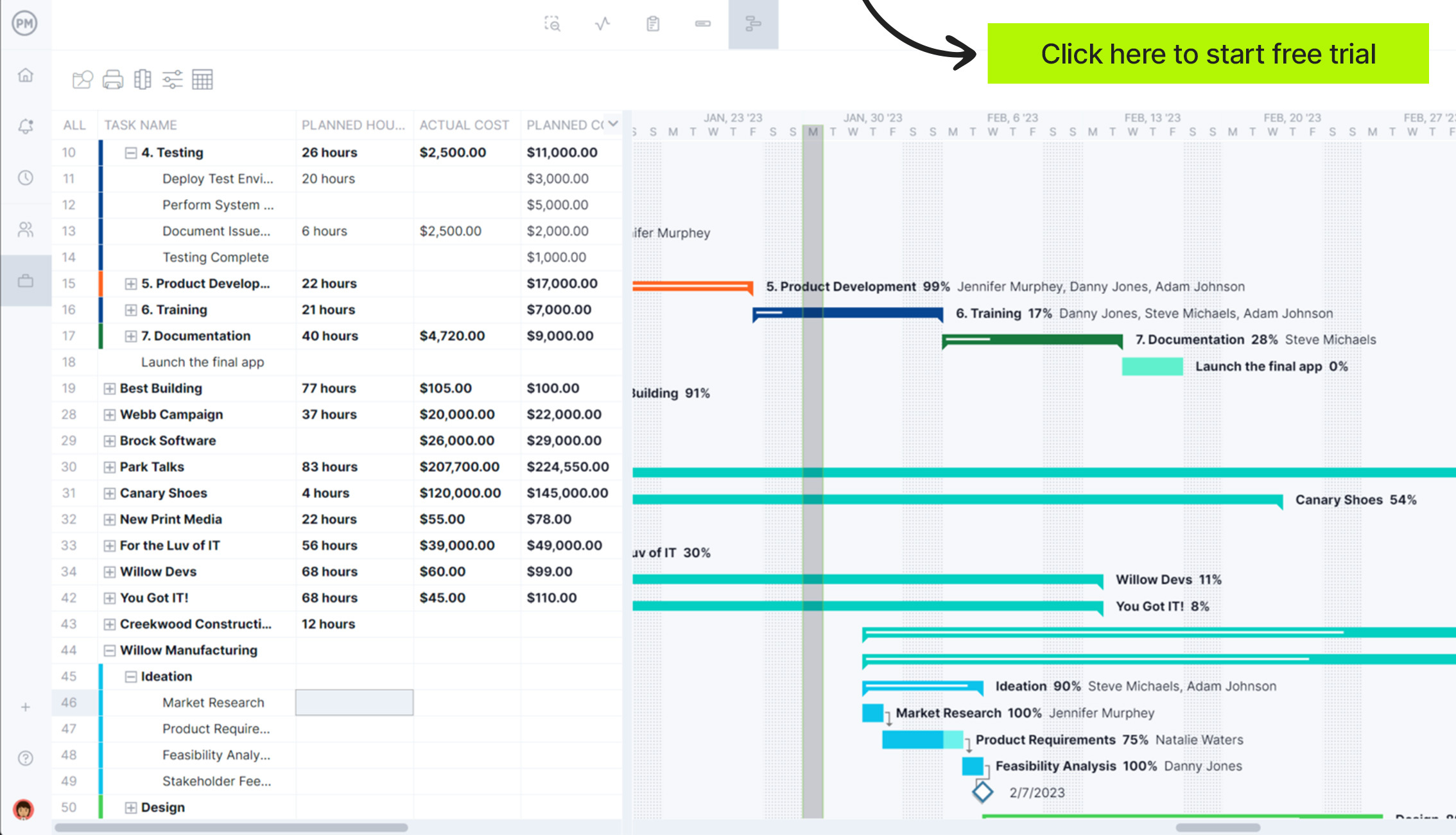
Why You Need a Program Proposal Template
A program proposal template helps establish a foundation before launching any major initiative. It forces you to define objectives, deliverables, stakeholders and success metrics early in the process. A structured template reduces the risk of missing critical details and ensure that your program aligns with organizational strategy and available resources.
Beyond clarity, a template helps standardize the proposal process across departments. This consistency makes it easier for leadership to compare and prioritize multiple proposals. It also helps teams stay organized, communicate more effectively and build a stronger case for approval by presenting information in a logical, professional format.
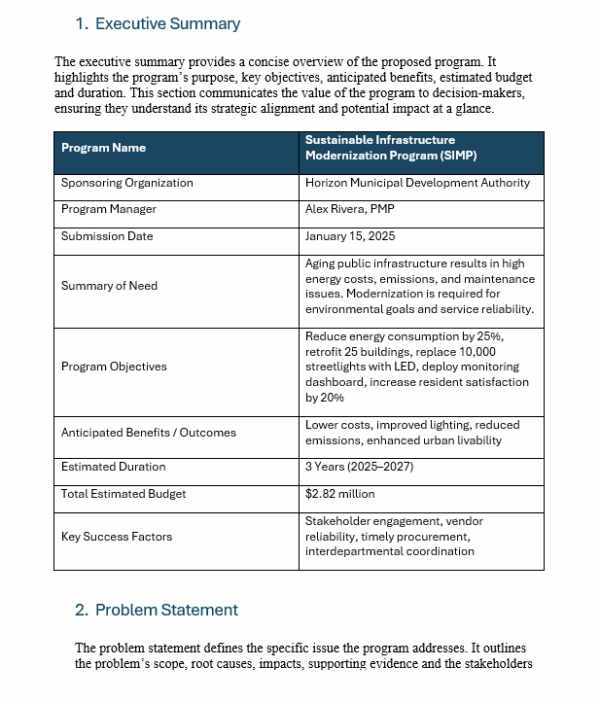
When to Use a Program Proposal Template
Use a program proposal template any time you are introducing a new initiative, requesting funding or seeking approval for a major cross-functional project. It’s especially useful in the early planning stages when you need to translate a strategic concept into a concrete plan that includes objectives, timelines and expected outcomes.
Using a template is also valuable when refining or expanding existing programs. Whether you are scaling up a successful initiative or addressing performance gaps, a proposal template helps ensure the plan is well-documented and easy to evaluate. This leads to better communication with stakeholders and smoother implementation once the program begins.
Who Should Use This Free Program Proposal Template?
This free program proposal template is ideal for program managers, department heads, executives and team leaders responsible for planning and presenting new initiatives. It helps anyone who needs to build a strong business case for a program, whether in government, nonprofit or corporate environments.
When teams use this template, they can collaborate more effectively, define responsibilities and align on objectives before work begins. It simplifies the approval process by providing a structured format that highlights key information such as goals, timelines, costs and benefits. With this foundation, teams can move from proposal to execution faster and with greater confidence.
How to Use This Program Proposal Template for Word
This program proposal template guides you through creating a professional and structured proposal. Each section defines a core element of program planning, from identifying the problem to outlining objectives, governance, resources and performance measures. Understanding these components ensures clarity, alignment among stakeholders and informed decision-making throughout the program lifecycle. The included charts allow you to organize data clearly while providing a reference for tracking progress and outcomes.
1. Executive Summary
The executive summary provides a concise overview of the proposed program. It highlights the program’s purpose, key objectives, anticipated benefits, estimated budget and duration. This section communicates the value of the program to decision-makers, ensuring they understand its strategic alignment and potential impact at a glance.
| Program Name | Sustainable Infrastructure Modernization Program (SIMP) |
| Sponsoring Organization | Horizon Municipal Development Authority |
| Program Manager | Alex Rivera, PMP |
| Submission Date | January 15, 2025 |
| Summary of Need | Aging public infrastructure results in high energy costs, emissions and maintenance issues. Modernization is required for environmental goals and service reliability. |
| Program Objectives | Reduce energy consumption by 25%, retrofit 25 buildings, replace 10,000 streetlights with LED, deploy monitoring dashboard, increase resident satisfaction by 20% |
| Anticipated Benefits / Outcomes | Lower costs, improved lighting, reduced emissions, enhanced urban livability |
| Estimated Duration | 3 Years (2025–2027) |
| Total Estimated Budget | $2.82 million |
| Key Success Factors | Stakeholder engagement, vendor reliability, timely procurement, interdepartmental coordination |
2. Problem Statement
The problem statement describes the specific issue the program addresses. It outlines the problem’s scope, root causes, impacts and supporting evidence. It identifies affected stakeholders and explains why timely action is required to mitigate risks, improve performance and meet organizational or regulatory goals.
| Issue Area | Aging Public Infrastructure |
| Description of the Problem | Public buildings and lighting systems are outdated, inefficient and costly to maintain, consuming 40% more power than comparable municipalities |
| Supporting Evidence / Data | 2024 audit revealed $1.2M in excess energy costs and increasing emissions |
| Stakeholders Affected | City residents, employees, environmental agencies, budget planners |
| Impact of the Problem | Financial strain, environmental harm, reduced satisfaction, reputational risks |
| Root Causes Identified | Deferred maintenance, obsolete systems, lack of energy management, limited investment |
| Current Gaps or Limitations | No unified monitoring system, outdated policies, fragmented oversight |
| Why Action Is Needed Now | To meet carbon-neutral goals, improve efficiency, enhance public trust |
3. Program Purpose, Goals and Objectives
This section explains the program’s purpose and strategic alignment, and defines measurable goals and objectives. Goals represent broad desired outcomes, while objectives specify measurable actions to achieve these goals. Clear articulation ensures accountability, coordination and successful program execution.
Program Purpose and Goals
| Component | Details |
| Purpose Statement | Modernize infrastructure by improving energy efficiency, reducing emissions and optimizing resources |
| Strategic Alignment | Supports city’s Green2030 initiative and development plan for sustainability and quality of life |
| Primary Goals | Upgrade public facilities, reduce operational costs, increase accountability, foster citizen confidence |
Program Objectives
| Objective | KPI / Target | Timeline | Responsible Party |
| Retrofit 25 public buildings | 20 % energy savings per building | Jan 2025 – Dec 2026 | Construction Lead |
| Replace 10,000 streetlights with LED | 95 % of installations on schedule | Apr 2025 – Jun 2026 | Electrical Team Lead |
| Implement centralized energy monitoring dashboard | 1 fully operational system | Aug 2025 – Mar 2027 | IT Systems Lead |
| Achieve city-wide energy cost reduction | $500,000 annual savings by 2027 | Jan 2027 – Dec 2027 | Finance Analyst |
| Improve resident satisfaction | ≥ 80 % positive rating | Jan 2027 – Dec 2027 | Communications Officer |
4. Program Scope
Program scope identifies all included work packages, deliverables, exclusions and constraints. It defines what the program will and will not cover and sets expectations for completion and acceptance.
| Work Package / Task | Deliverable | Description | Responsible Party | Acceptance Criteria | Exclusions / Constraints |
| WP1 – Energy Audit | City Energy Assessment Report | Comprehensive audits of municipal buildings and lighting systems | Energy Team Lead | 100% assets assessed | Private facilities not included |
| WP2 – Smart Lighting | LED Installation | Replace outdated streetlights with energy-efficient LED systems | Electrical Lead | 95% zones operational | Decorative lighting excluded |
| WP3 – Building Retrofits | Retrofit Completion Certificates | Upgrade HVAC and insulation in 25 buildings | Construction Lead | Verified 20% energy reduction | New constructions excluded |
| WP4 – Monitoring System | Central Energy Dashboard | Deploy software platform to track energy metrics | IT Systems Lead | System fully integrated | Mobile app excluded |
5. Program Management Methodology
Defines the program management framework, phased approach, tools, reporting structure, quality assurance, change control and communication plan. It ensures consistent execution, risk management and alignment with strategic goals across all workstreams.
| Methodology Component | Description |
| Program Management Framework | PMI Standard for Program Management integrating predictive and adaptive techniques |
| Phased Approach | Initiation & Planning, Execution, Monitoring & Control, Closure |
| Tools & Software | ProjectManager for scheduling, dashboards and reporting, MS Excel for budget, Power BI for analytics |
| Reporting Structure | Weekly internal, monthly governance, quarterly executive summaries |
| Quality Assurance | Independent audits and deliverable review against acceptance criteria |
| Change Control Process | Formal change requests reviewed and approved by Steering Committee |
| Communication Plan | Email, dashboards, workshops to ensure transparency and alignment |
6. Program Governance
Outlines governance roles, responsibilities, decision authority and reporting frequency. Ensures accountability and clarity on who makes decisions and monitors program progress.
| Governance Role | Name / Position | Responsibilities | Decision Authority | Reporting Frequency |
| Program Sponsor | Maria Gonzalez – Director | Approves funding and scope changes | High | Quarterly |
| Program Manager | Alex Rivera | Oversees planning and execution | Medium | Biweekly |
| Steering Committee | City Infrastructure Board | Provides strategic direction and approves phase transitions | High | Monthly |
| Functional Leads | Energy, Construction, Finance, IT Leads | Manage workstreams and report progress | Low | Weekly |
7. Stakeholder Engagement Plan
Defines how stakeholders will be identified, engaged and communicated with throughout the program. Includes their interest, influence, engagement strategy and communication frequency to ensure alignment and transparency.
| Stakeholder | Interest / Impact | Influence | Engagement Strategy | Method | Frequency |
| City Residents | High | Medium | Inform and consult on schedules and benefits | Community meetings, website updates | Monthly |
| City Council | High | High | Secure policy and funding approvals, report outcomes | Presentations, policy briefs | Quarterly |
| Contractors & Vendors | Medium | Medium | Coordinate procurement and compliance | Email, progress calls | Weekly |
| Environmental NGOs | High | Low | Collaborate on sustainability metrics and outreach | Reports, workshops | Biannually |
| Utility Providers | Medium | High | Partner on smart grid integration and energy savings | Joint planning sessions | Monthly |
8. Program Resource Requirements
Lists all human and non-human resources needed to execute the program. Defines skills, quantities, responsibilities, availability and purpose for proper allocation and planning.
Human Resources
| Role / Position | Department | Quantity | Skills / Qualifications | Availability | Assigned Workstream |
| Program Manager | PMO | 1 | PMP, stakeholder management | Jan 2025 – Dec 2027 | All |
| Energy Engineer | Energy Efficiency | 2 | Mechanical/electrical engineering, LEED | Feb 2025 – Oct 2026 | WP1, WP2 |
Non-Human Resources
| Resource | Description | Quantity | Purpose | Required Date | Responsible |
| LED Fixtures | Lighting components | 10,000 | Replace old streetlights | May 2025 | Electrical Lead |
| Construction Equipment | Lifts and cranes | 4 | Install lighting | May 2025 | Construction Lead |
9. Program Budget
Provides a detailed breakdown of costs by category, description, estimated value and funding source. Enables financial planning, oversight and accountability.
Provides a detailed breakdown of costs by category, description, estimated value and funding source. Enables financial planning, oversight and accountability.
| Category | Description | Estimated Cost (USD) | Funding Source |
| Labor | Salaries and consultants | $1,200,000 | City Budget |
| Materials | LED, wiring, insulation | $900,000 | Green Fund |
| Equipment | Construction machinery | $350,000 | City Equipment Pool |
| Travel / Logistics | Transport and site visits | $120,000 | City Budget |
| Contingency | Unforeseen risks | $250,000 | General Reserve |
| Total | $2,820,000 |
10. Risk Management Plan
Identifies potential risks, their likelihood and impact, owners, mitigation strategies and contingency plans. Helps proactively manage threats to program success.
| Risk ID | Description | Likelihood | Impact | Owner | Mitigation Strategy | Contingency Plan |
| R-01 | Procurement delays | M | H | Procurement Lead | Alternate suppliers, staggered orders | Use existing inventory |
| R-02 | Public opposition | M | M | Communications Officer | Early outreach | Adjust work hours |
11. Program Monitoring and Performance Measurement
Defines KPIs and metrics to track program performance. Provides insight into energy reduction, schedule adherence, budget variance and resident satisfaction, allowing course corrections as needed.
| KPI / Metric | Description | Target | Measurement Method | Frequency | Status |
| Energy Reduction | Overall municipal energy consumption reduction | 25% by 2027 | Smart dashboard reports | Quarterly | ▲ Improving |
| Schedule Adherence | % milestones achieved on time | ≥ 90% | Gantt tracking | Monthly | ● On Track |
12. Program Benefits Management
Documents expected benefits, assigns ownership, expected ROI and realization timeline. Ensures program delivers value and positive outcomes for stakeholders.
| Benefit ID | Description | Expected Value / ROI | Owner | Timeline |
| B-01 | Reduced municipal energy costs | $500,000 annual savings | Finance Department | Year 2 onwards |
| B-02 | Enhanced public lighting coverage | 30% drop in complaints | Public Works | Year 1–2 |
| B-03 | Improved environmental sustainability | 2,000 tons CO₂ reduction/year | Sustainability Office | Year 3+ |
What Other Templates Can Help with Program Management?
Using templates can simplify program management by providing ready-made structures to organize work, track progress and communicate with stakeholders. They reduce manual effort, standardize reporting and ensure nothing falls through the cracks. While a program proposal template helps plan initiatives, other templates can help manage execution, monitor performance and visualize the portfolio.
Program Roadmap Template
Download this free program roadmap template for a high-level view of program initiatives over time. It outlines key milestones, deliverables and deadlines, helping managers align projects with strategic objectives. This template ensures all stakeholders understand the sequence and timing of program activities and allows you to communicate progress and dependencies clearly across multiple teams.
Project Portfolio Template
Use this free project portfolio template to help organizations manage multiple projects within a program or across programs. It allows you to track project status, resource allocation, budgets and risks in one consolidated view. Using this template, managers can prioritize projects, identify bottlenecks and make informed decisions to optimize the overall portfolio for strategic success.
Project Dashboard Template
This free project dashboard template provides real-time insights into project performance, including progress, resource utilization, budgets and upcoming deadlines. It allows managers to monitor multiple projects at a glance, quickly identify issues, and share updates with stakeholders. Dashboards enhance transparency, improve decision-making and ensure teams stay aligned with program goals.
How to Manage Projects, Programs and Portfolios With ProjectManager
Managing projects, programs and portfolios requires organization, visibility and control over tasks, resources and deadlines. ProjectManager provides a centralized platform to plan, execute and monitor work in real time. With multiple project views, intuitive dashboards and collaborative tools, managers can keep teams aligned and ensure objectives are met efficiently, whether managing a single project or a complex portfolio.
Streamline Resource Management Across All Projects
ProjectManager allows you to allocate and manage resources efficiently across projects and programs. Managers can assign tasks to team members, track workloads and avoid over- or under-utilization. The software provides timesheets, cost tracking and labor analytics, so you can control budgets and forecast needs.Resource views let you see who is available and when, and AI-powered recommendations help optimize assignments based on skills, availability and project priorities. This ensures the right people are working on the right tasks at the right time.
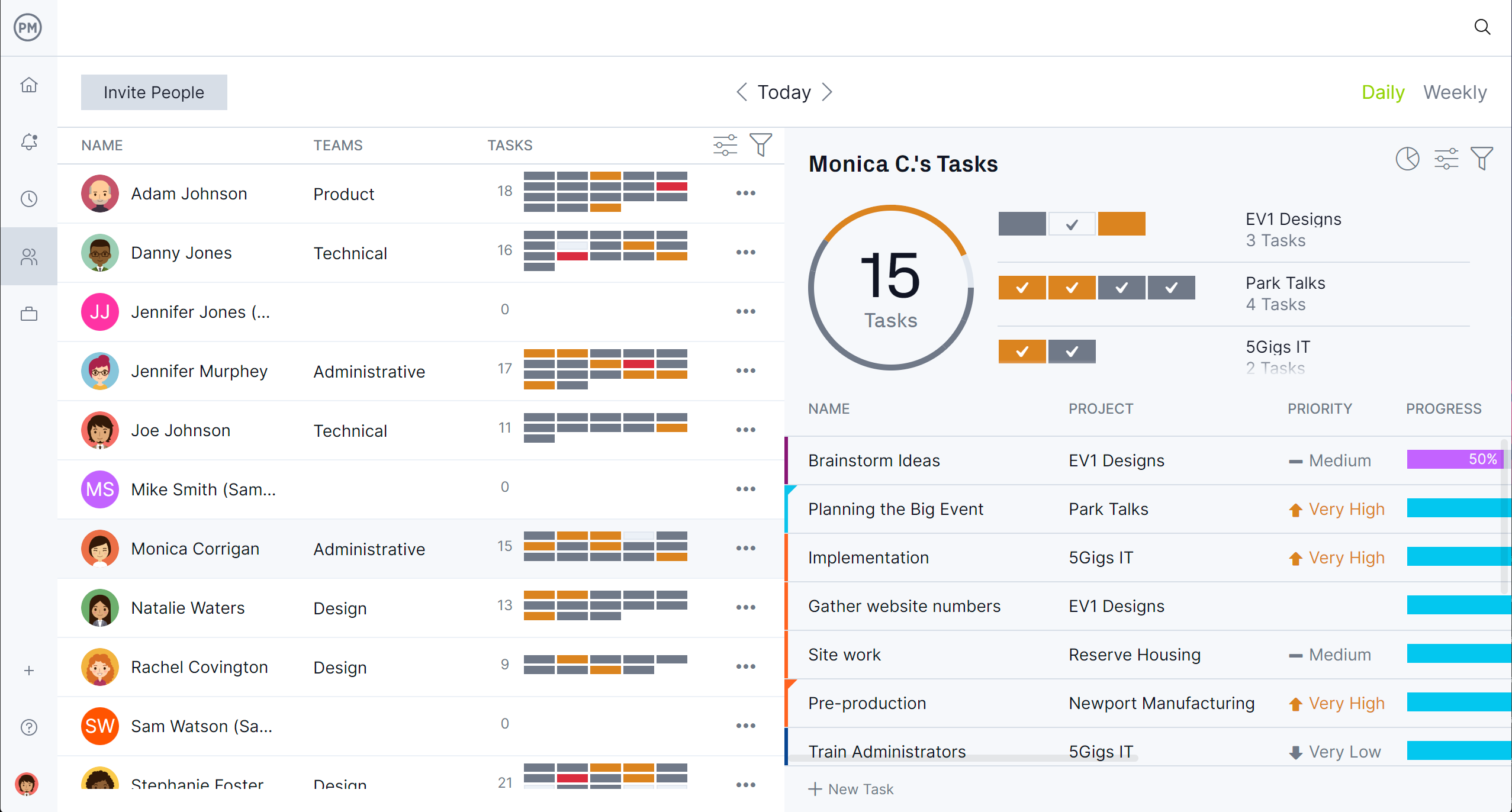
Track Progress, Deadlines and Performance With AI-Enhanced Insights
Tracking project progress has never been easier with ProjectManager’s real-time dashboards, automated reporting and customizable alerts. You can monitor timelines, milestones and dependencies across projects, programs and portfolios. AI-powered features analyze data to identify risks, suggest schedule adjustments and provide insights into resource allocation and performance trends.Custom reports and charts allow managers to make informed decisions, communicate updates to stakeholders and keep projects on track, all within one integrated platform.
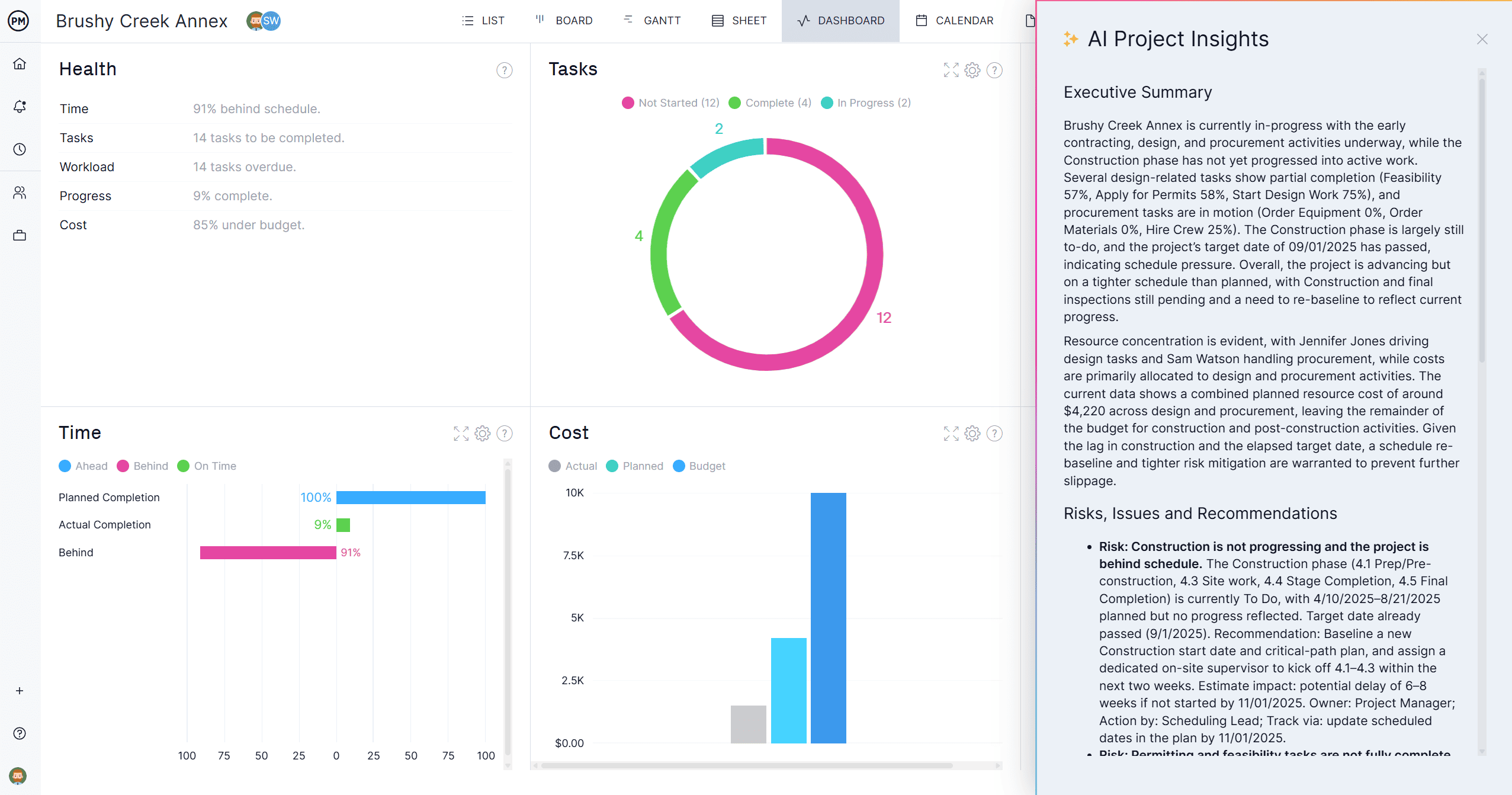 Related Program Management Content
Related Program Management Content
A program proposal template sets one up. Then comes the real work of managing that program. To learn more about the program management process, check out the links below on making a plan, downloading more free templates and other useful material.
- Program Management: The Ultimate Guide
- How to Make a Program Management Plan (Free Template Included)
- 10 Free Program Management Templates for Excel and Word
- 10 Program Management Best Practices for Successful Programs
- Program Life Cycle Management: Mastering Program Phases
ProjectManager is online project and portfolio management software that connects teams whether they’re in the office or out in the field. They can share files, comment at the task level and stay updated with email and in-app notifications. Get started with ProjectManager today for free.
